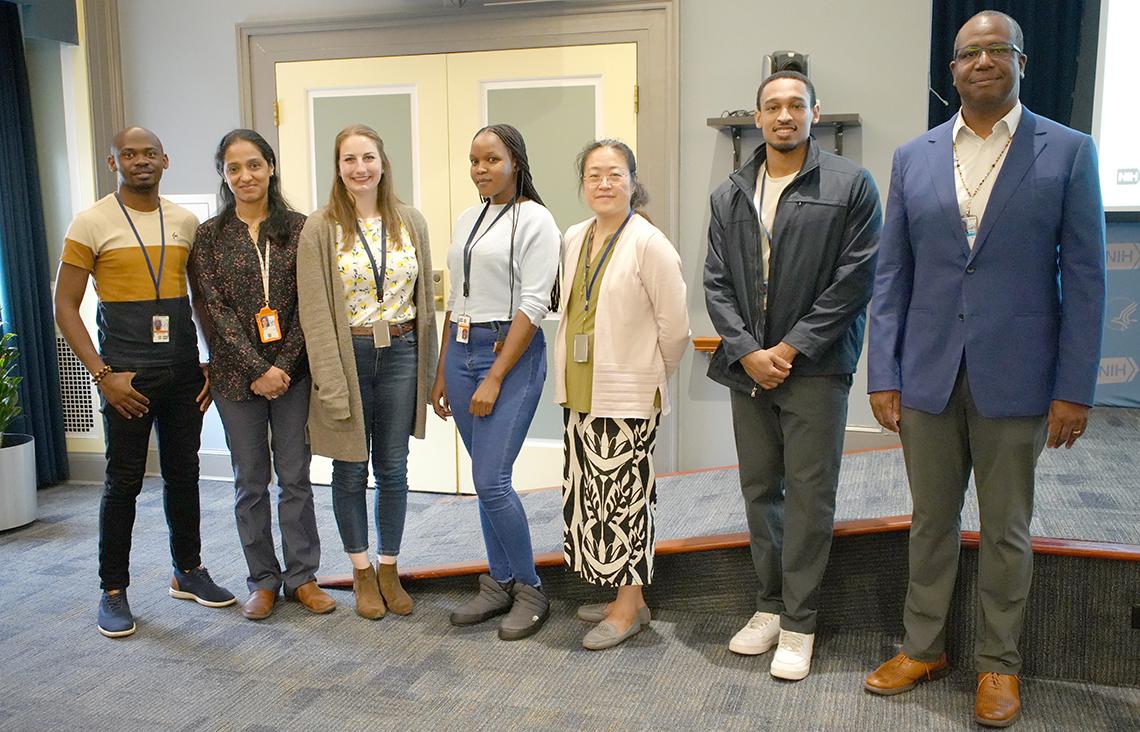‘A Complex Tapestry’
Hanchard Explores Genomics of African Populations

Photo: Dana Talesnik
The human genome can reveal all kinds of clues toward understanding, diagnosing and treating genetic diseases. Most genomic studies to date, though, have focused on European ancestry and therefore could be missing out on a goldmine of genetic variation found in other people.
“African populations on average are going to have much more genetic variation per genome than those of European ancestry,” said Dr. Neil Hanchard, senior investigator at the National Human Genome Research Institute (NHGRI). Africa’s populations are much older, he noted. Many groups migrated; lineages diverged.
“As people move, they’re now interacting with different diets, different infectious agents and the different ecologies that have changed over time,” Hanchard said. “We have this setup for a very complex genetic architecture.”
In fact, there are more than 2,000 different ethnic groups across the African continent. “We need to be sequencing far more Africans to capture the full variation,” he said.

Photo: Dana Talesnik
Hanchard is studying several childhood disorders—sickle cell disease and pediatric HIV, malnutrition and hypertension—that are more common in populations of African ancestry. He spoke at a recent NIH Director’s Seminar.
A geneticist and clinical researcher, Hanchard described his collaboration with Human Heredity and Health in Africa (H3Africa)—a consortium funded for 10 years by NIH, the Wellcome Trust and the African Academy of Sciences—working to identify and describe genetic variants in diverse African populations.
After 10 years, H3Africa boasts more than 50 projects in 34 African countries with more than 100,000 study participants. All principal investigators must be from the African country where the grant originated, Hanchard explained, to root this initiative in Africa and better facilitate community engagement.
Hanchard described a “complex tapestry” of interwoven populations across the African continent. When H3Africa began, Nigeria was the sequencing hub, and Yoruba and Igbo people became proxies for West African genetic variation. Soon the program expanded to include 50 ethno-linguistic groups.

Delving into this data, “we’re starting to see the full breadth of diversity,” Hanchard said, including some unusual outliers with respect to geography. The Berom people of Nigeria, for example, are genetically removed from other West African groups due to earlier migration patterns.
“People are using Yoruba or Igbo as proxies for Africa but they’re probably not even great proxies for Nigeria,” he said.
H3Africa researchers have uncovered more than three million novel single-nucleotide variants, most in newly sampled population groups. More specifically, they’ve found a substantial number of loss-of-function (LOF) variants—associated with disease—shared across all African populations.
“What’s really interesting is we can see a number of genes that are known Mendelian genes [single-gene diseases],” he said. And they’re occurring in much higher frequency in these populations than expected.
Some of Africa’s genetic variation evolved to spur immunity, following predictable geographic patterns.
The variant responsible for sickle cell disease, for example, is most prevalent across equatorial parts of Africa where it evolved as protection against malaria. This allele (gene variant) is much less common in the southern, drier parts of Africa.
Also more common in equatorial parts of Africa, the APOL1 allele predisposes people to end-stage kidney disease. But that same variant protects against the parasitic disease trypanosomiasis or, African sleeping sickness.
Researchers also have found variants in certain African countries that are distinct from all other African genomes they’d sequenced.

Photo: Dana Talesnik
In these cases, Hanchard said, “We have this interplay of ancestry and genetic variation that’s medically relevant.”
Hanchard focused much of his talk on pediatric HIV. An H3Africa effort called CAfGEN (Collaborative African Genomic Network), in conjunction with Hanchard’s prior affiliation Baylor University, is studying pediatric HIV disease progression. There’s been a marked decline in new childhood HIV infections due to efforts to prevent mother-to-child transmission. But HIV remains pervasive, particularly in sub-Saharan Africa, where more than 1.3 million children are living with HIV.
From the CafGEN clinical cohort, researchers have observed that without antiretroviral therapy, HIV-positive children progress at different rates. At one end of the spectrum are the long-term non-progressors—adolescents with no symptoms—and at the other end are the rapid progressors who develop AIDS-like symptoms within a couple of years.
Genomic sequencing shows alleles common in rapid progressors, including ones specific to certain African regions, and others associated with HIV protection. Deep dives into these genes at the individual and population level are revealing new clues.
Researchers found a correlation between LOF genes and country-specific HIV mortality. Certain variants are only seen among Africans such as a damaging, rare variant in a gene known to enable HIV replication.
“These variants are much more [common] in the GI tract and reproductive tract, which is interesting because that’s the interface for vertical transmission between mother and child,” Hanchard said.
Overall, Hanchard emphasized, in all of their testing, “We have to be mindful of the ancestries we’re dealing with, and that Africa is not just a monolith.” And so much of this work is enabled and buttressed by local clinicians and investigators.
“It’s really important to do [genetic mapping] in an equitable framework where there’s partnership, empowerment and community engagement,” he said, “where we can start by building the research capacity and have it ripple out so it [benefits] everyone.”
